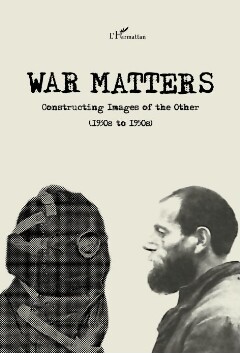Page 113 [113]
The Faces of the Enemy in the Two World Wars
was more frequent during WWI. During WWII the caricatures no longer referred
to those myths which needed more serious knowledge of mythology. The editors
of Magyarsdg almost never used these symbols in the first place. In Kladderadatsch
this change cannot be explained with a change in caricaturists. Rather, in both
Hungary and Germany a new generation of readers grew up, perhaps with less of
a classical education, who could not, therefore, be addressed through complicated
mythological stories.? The caricaturists mocked the Other using various methods:
they depicted the enemy as ugly human beings or as animals, they reinterpreted
scenes from Roman, Greek and German mythologies as well as the Bible. Before
I discuss these, however, I will analyse the self-representations.*
Depiction of the Self
One of the most important functions of the drawings in Borsszem Janké was the
strengthening of a positive self-image and of faith in victory. The pictures provide
an insight into the glorious life of the military by an artist, Akos Garay, who also
fought in the battlefields (BJ*, August 2, 1914). However, these drawings of scenes
of ordinary life, a genre which aims to represent ‘reality’, lack one aspect of wartime
reality—specifically, that of suffering. Naturally, one cannot see either lost battles
or dead soldiers, only hussars bearing their serious injuries heroically (BJ, Septem¬
ber 20, 1914). The defeated enemy appears in only one context: when its depiction
was to accentuate the humanity of the Hungarians, for example representing them
helping the injured enemy on the eastern front.
Drawings of heroes were not used to strengthen positive self-representations in
Magyarsdg. On the contrary, its caricaturists gave positive meanings to the Hungar¬
ian fascist symbol, the arrow cross, which was depicted as destroying the enemy,
bringing a new revival (Fig. 42) and reconstituting the Hungarian borders to those
before the Peace Treaty of Trianon (1920). The arrow cross is often depicted with
sunlight or fire next to it, although the swastika also occurs next to these in many
caricatures (M, July 11, 1941). Surprisingly the two symbols were published more
often in Magyarsdg than in Kladderadatsch. In the German comic paper during
WWI, German self-image was strengthened by depicting heroic German soldiers,
> In Hungary the Ancient Greek language and mythology were not compulsory subjects between 1890
and 1924, and the interest in Greek decreased drastically (Lovdsz 2010: 45-52). The hegemony of Latin
had also disappeared by the 1920s: the education reform of 1924 decreased the teaching of Latin greatly
(Borzsäk 1990: 74-77). In German grammar schools both Latin and Greek remained compulsory sub¬
jects, taught in a high number of classes per week (Karsen 1923: 14-15), although only 9% of the students
went to this type of school and the educated elite did not vote for the Nazis (Kuhlmann 2006: 410-411)
and thereby was not the target of Nazi propaganda.
* I will not discuss the anti-Semitism or the traditional depiction of Jews in this chapter (see, however,
Davies, this volume), although this will be a topic of another study I am planning to undertake.
> In this chapter I will abbreviate the titles of comic papers in footnotes and examples as follows: Borsszem
Janké (BJ), Kladderadatsch (K), Magyarsdg (M). The figures only illustrate the point, and observations are
based on a higher number of caricatures.
111

